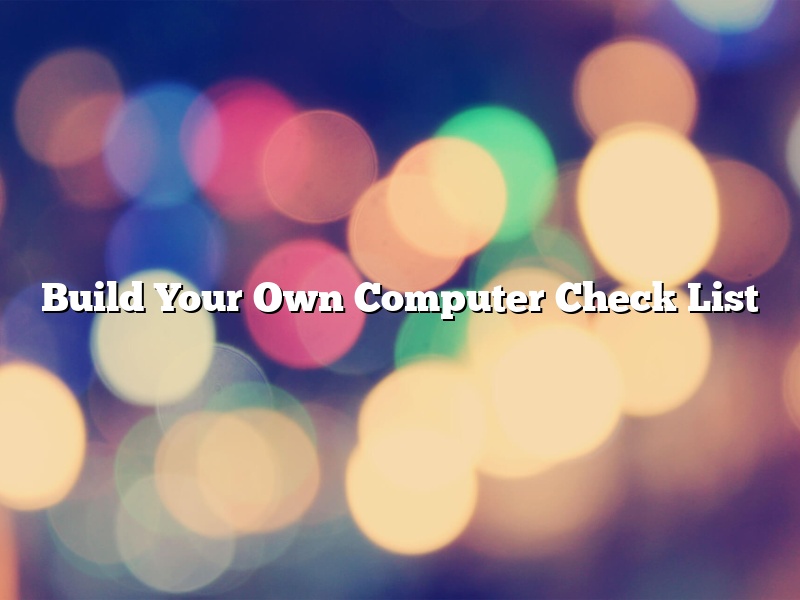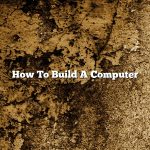Building your own computer can be a fun and rewarding experience. It can also be a great way to save money. But, before you start building, you need to make sure you have all the necessary components. This computer check list will help you do just that.
One of the most important components of a computer is the processor. The processor is responsible for processing all the data that passes through the computer. When choosing a processor, you need to consider the type of tasks you will be using your computer for. For basic tasks like web browsing and word processing, a dual-core processor should be adequate. If you plan on using your computer for more intensive tasks like gaming or video editing, you will need a more powerful processor.
Another important component is the motherboard. The motherboard is the central component of the computer and is responsible for connecting all the other components. When choosing a motherboard, you need to make sure that it is compatible with the processor you choose. You also need to make sure that it has the appropriate number of slots for the amount of memory you want to install.
The amount of memory your computer has is also important. Memory is used to store data that is currently being processed by the processor. The more memory your computer has, the more tasks it can handle at once. When choosing memory, you need to make sure that it is compatible with the motherboard. You also need to choose the right type of memory. There are two main types of memory – DDR3 and DDR4. DDR3 is the older type of memory and is slowly being phased out. DDR4 is the newer type of memory and is faster and more efficient.
Another important component is the hard drive. The hard drive is where all your data is stored. When choosing a hard drive, you need to decide how much storage space you need. If you only plan on storing a few files, a small hard drive should be adequate. If you plan on storing a lot of files, you will need a larger hard drive. You also need to consider the speed of the hard drive. The faster the hard drive, the faster your computer will be.
To connect all these components, you need a case. The case is the enclosure that holds all the components. When choosing a case, you need to make sure that it is compatible with the motherboard and the processor. You also need to make sure that it has the appropriate number of slots for the amount of memory you want to install.
Other components you will need include a power supply, a graphics card, and a sound card. The power supply is responsible for supplying power to the other components. The graphics card is responsible for displaying images on the screen. The sound card is responsible for processing sound. When choosing these components, you need to make sure that they are compatible with the motherboard and the processor.
Once you have assembled all these components, you need to install the operating system. The operating system is the software that allows you to interact with the computer. There are many different types of operating systems to choose from, including Windows, Mac, and Linux.
Once you have installed the operating system, you need to set up your user account. This is where you enter your name and password and choose the settings for your computer.
Once you have completed all these steps, your computer is ready to use.
Contents
What do I need to build a computer checklist?
There are a few things you will need in order to build your own computer. Below is a checklist of the items you will need.
1. Motherboard – The motherboard is the main circuit board in a computer. It contains the connectors for the CPU, RAM, graphics card, and other peripherals.
2. CPU – The CPU is the central processing unit of the computer. It is responsible for executing the instructions of a computer program.
3. RAM – RAM stands for Random Access Memory. It is a type of storage that allows data to be accessed randomly. The more RAM you have, the more programs you can run at the same time.
4. Graphics card – The graphics card is responsible for displaying images on the monitor.
5. Hard drive – The hard drive is where the data for your computer is stored.
6. Power supply – The power supply provides power to the components of the computer.
7. Case – The case is the enclosure that houses the components of the computer.
8. CPU cooler – The CPU cooler is used to cool the CPU.
9. Operating system – The operating system is the software that runs the computer.
10. Software – The software is the programs that run on the computer.
Is it cheaper to build your own computer?
Building your own computer can be a great way to save money, especially if you’re comfortable with DIY projects. However, there are a few things to keep in mind before you start.
The first thing you need to do is figure out which components you’ll need. This can be tricky, as there are a lot of different options available. You’ll want to choose a motherboard, a processor, a power supply, memory, a hard drive, and a case.
One of the benefits of building your own computer is that you can choose the components that are best suited for your needs. For example, if you do a lot of gaming, you may want to choose a powerful processor and a high-end graphics card. If you need a computer for basic tasks, you may be able to get away with using a less expensive processor and motherboard.
The other thing to keep in mind is that you’ll need some basic tools and supplies. These include a screwdriver, a motherboard stand, thermal paste, and a case fan.
Once you have all of the components, it’s time to start putting the computer together. This can be a bit tricky, but there are a lot of online resources that can help. You’ll want to follow the instructions carefully, as getting the components wrong can cause problems.
One thing to keep in mind is that building your own computer can be time consuming. It may take a few hours to put everything together, and you’ll also need to install the operating system and any software programs that you want to use.
So is it cheaper to build your own computer? In most cases, the answer is yes. You can save money by choosing less expensive components, and you’ll also avoid the mark-up that is typically charged by computer stores. However, it’s important to keep in mind that there is a bit of a learning curve, and it may take some time to put everything together.
What order should you build a PC?
Building a PC can be a daunting task for first time builders, but with a little planning it can be a fun and rewarding experience. The first question you have to ask yourself is what are you going to use your PC for? Gaming, video editing, web browsing, etc. Each of these activities requires a different set of components, so you need to tailor your build accordingly.
If you’re just looking to do some light browsing and office work, then you can get away with a relatively inexpensive build. For gaming, you’ll need a more powerful system with a better graphics card, CPU, and memory. The same is true for video editing, which requires a lot of processing power.
With that in mind, let’s take a look at the order you should build a PC.
1. The Case
The first thing you need is a case. This will house all of your components and provide a place for them to cool down. Make sure to get a case that is big enough to accommodate your components.
2. The Power Supply
The power supply is the next thing you need. This supplies power to your components and keeps them running. Make sure to get a power supply that is big enough for your system.
3. The Motherboard
The motherboard is the central hub of your PC. It connects all of your components and allows them to communicate with each other. Make sure to get a motherboard that is compatible with the components you plan to use.
4. The CPU
The CPU is the brains of your PC. It processes all of the data and tells the other components what to do. Make sure to get a CPU that is compatible with your motherboard.
5. The Memory
The memory is what stores all of the data your PC needs. Make sure to get a memory that is compatible with your motherboard and CPU.
6. The Graphics Card
The graphics card is responsible for rendering the images on your screen. Make sure to get a graphics card that is compatible with your motherboard and CPU.
7. The Hard Drive
The hard drive is where all your data is stored. Make sure to get a hard drive that is big enough for your needs.
8. The Operating System
The last thing you need is an operating system. This is the software that runs your PC. Make sure to get a copy of Windows 10 if you plan to use it.
When building a computer what do I install first?
When building a computer, there are a few things you need to install first. The most important of these is the operating system. This is the software that controls everything on your computer. It’s what you use to launch programs, browse the internet, and so on.
There are a few different operating systems to choose from. The most popular are Windows and MacOS. Linux is also a popular option, and there are many different distributions to choose from.
Once you’ve chosen an operating system, you need to install it on your computer. This is usually done by burning the operating system to a disc or by downloading it from the internet.
Once the operating system is installed, you can start installing your other software. This includes your web browser, your email client, your music player, and so on.
It’s important to install your software in the correct order. Some software depends on other software being installed first. For example, your web browser may not work properly if you don’t have the correct fonts installed.
So, what do you install first? The answer depends on your operating system and the software you want to install. However, a good rule of thumb is to install your operating system first, then your other software.
How much RAM is enough?
Ram, short for random access memory, is a key part of any computer. It is what the computer uses to store information and run programs. When it comes to ram, more is always better, but how much is enough?
Most computers come with 4 or 8 gigabytes of ram. That is more than enough for the average person. If you are a power user, or you do a lot of photo or video editing, you may need more. Up to 16 gigabytes of ram is enough for most people. If you are a professional user, or you do a lot of heavy-duty number crunching, you may need more. 32 gigabytes of ram is the most you really need, but most people will never need that much.
So, how do you know how much ram you need? The best way to find out is to try different amounts and see what works best for you. If you are not sure how much ram you need, start with 4 or 8 gigabytes and see how that works for you. If you need more, you can always add more later.
Is building a PC hard?
Is building a PC hard?
For the most part, building your own PC is not hard. It does require a bit of research and some technical know-how, but if you can follow instructions, you can do it. There are a few things to keep in mind, however, when building your own PC.
First, you need to decide which components to use. This can be a daunting task, as there are a lot of choices available. But, fortunately, there are a lot of online resources that can help you make the right decision.
Once you’ve decided on the components, you need to assemble them. This usually involves attaching the motherboard to the case, installing the CPU, and adding the memory, among other things. Again, there are a lot of online resources that can help you with this process.
Finally, you need to install the operating system and drivers. This is usually a simple process, but it’s important to make sure you have the right drivers for your components.
Overall, building your own PC is not hard, but it does require a bit of research and some technical know-how. If you can follow instructions, you can do it. Just make sure you choose the right components and install the drivers correctly.
Is it better to build or buy a PC 2022?
There is no definitive answer when it comes to deciding whether it is better to build or buy a PC. Ultimately, the decision depends on a variety of factors, including budget, individual needs, and level of expertise.
Building a PC can be cheaper in the long run, especially if the components are purchased individually rather than as part of a pre-built system. However, building a PC can also be more time-consuming, and it can be more difficult to find support if something goes wrong.
Buying a PC can be more expensive initially, but it can be easier to set up and use. Plus, most pre-built systems come with a warranty, which can be helpful if something goes wrong.
Ultimately, the best decision depends on the specific needs and budget of the individual.




